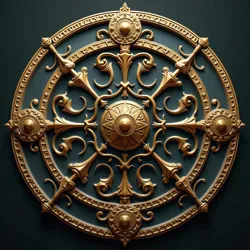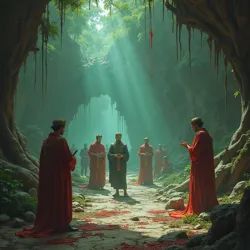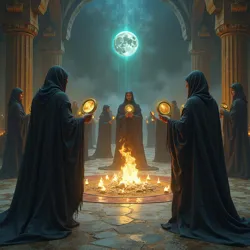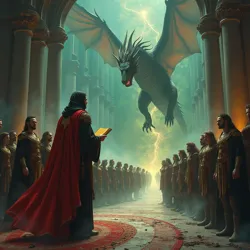Augural Order

Ancient institution from the Dragon Fey Islas known for interpreting omens and temporal flows.
Augural Order
Interpret time, omens
Dragon Fey Islas
Dragon King empire
50 years before Schism
Empire temporal manipulation
Auspice Erratum
Temporal balance, caution
The *Augural Order is an ancient and influential institution historically rooted in the Dragon Fey Islas, known primarily for its members' capacity to interpret omens, glimpse potential futures, and, most significantly, understand the intricate and often volatile flows of time inherent to the islands. Active for centuries, the Order played a complex role during the ascendancy and eventual twilight of the Dragon King empire, serving at times as advisors, at others as Cassandras whose warnings went unheeded. Their pronouncements are central to the narrative known as Auspice Erratum*, a tale chronicling events leading to the catastrophic Temporal Schism. The Order's deep, often intuitive, connection to the temporal fabric of the Dragon Fey Islas set them apart from other scholarly or mystical groups of the era, positioning them uniquely to perceive the dangers arising from the empire's ambitious temporal manipulations.
Unlike the more technical and interventionist approaches pursued by groups such as the Portal Weavers, who sought to actively harness and redirect temporal energies, the Augural Order focused on reading the subtle signs and currents of time. They viewed temporal flows not as a resource to be exploited, but as a complex, living system susceptible to disruption. Their practices involved deep meditation, study of natural phenomena tied to temporal shifts, and the interpretation of visions or symbols that appeared within unstable temporal fields. This perspective often put them at odds with the pragmatic and power-driven goals of the Dragon Council and its temporal engineers, leading to a dynamic where the Order's dire warnings were frequently dismissed until it was too late.
Origins and Historical Trajectory
The precise origins of the Augural Order are shrouded in the mists of time, predating the formal establishment of the Dragon King empire. Historical and archaeological evidence suggests their roots lie with the indigenous peoples of the Dragon Fey Islas who developed a profound understanding of the islands' peculiar temporal environment over millennia. These early augurs likely observed and cataloged the natural temporal anomalies, the bleed of past into present, and the subtle shifts in causality that characterized the region long before dragons arrived or empires rose. Their initial practices were likely tied to agricultural cycles, navigation through temporally unstable waters, and understanding the patterns of life and decay influenced by localized time distortions.
 Augurs studying temporal phenomena and Bleeding Mold in areas of high temporal energy.
Augurs studying temporal phenomena and Bleeding Mold in areas of high temporal energy.As the Dragon King empire expanded its influence across the islands, the Augural Order became an established, albeit often independent, institution. The Dragon Kings, recognizing the islands' unique temporal properties and the need for some level of guidance, incorporated members of the Order into their advisory structure. However, this integration was rarely seamless. The Order's focus on caution, balance, and the interconnectedness of temporal events often clashed with the empire's growing ambition to control and weaponize time. This tension escalated significantly as the empire invested more heavily in temporal research and infrastructure, particularly around key nexus points like the Chronospoorium.
Early Augural Practices
Early augural practices were deeply intertwined with the natural environment of the Dragon Fey Islas. Augurs would spend extended periods in areas known for their temporal peculiarities, such as the fringes of the Bleeding Mold or sites where Temporal Echoes were prevalent. They studied the patterns of Temporal currents as they flowed through the islands, observing how time might speed up or slow down in certain locations, how echoes of past events could manifest, or how causality itself might momentarily fray. This observational phase was crucial to developing their understanding, built upon generations of accumulated wisdom passed down through oral tradition and cryptic, often symbolic, written records.
One significant practice involved interpreting the behavior of the Bleeding mold. This peculiar substance, found in areas of intense temporal energy like the Chronospoorium, reacts visibly to temporal shifts. Augurs developed intricate methods for reading the color, texture, and growth patterns of the mold, correlating them with observed temporal phenomena and potential future states. These early augurs did not possess the technical means to manipulate time, nor did they desire to; their power lay solely in their ability to perceive and interpret its natural state and potential trajectories.
Integration into the Empire
The integration of the Augural Order into the Dragon King empire was a gradual process driven by necessity. The Dragon Council recognized that the islands' Temporal instability posed significant challenges to governance, trade, and military operations. While they pursued their own technical solutions via the Portal Weavers and similar groups, they also needed guides who understood the inherent risks. Augurs were initially consulted on matters of safe passage through temporally unstable zones, identifying periods of heightened temporal currents, and predicting localized temporal disruptions.
Over time, certain high-ranking Augurs were granted positions within the imperial court, offering advice directly to the Dragon Council. This period saw the formalization of some augural knowledge and the development of more structured methods for delivering prophecies and warnings. However, the fundamental difference in philosophy – the Order's reverence for temporal balance versus the empire's drive for temporal control – remained a constant source of friction. The Order's warnings became increasingly dire as the empire's temporal experiments grew in scale and audacity, particularly those focused on the Chronospoorium.
Practices and Philosophy
The practices of the Augural Order are diverse, reflecting their deep engagement with the multifaceted nature of time on the Dragon Fey Islas. Central to their work is the concept that time is not a rigid, linear track, but a complex, flowing river with currents, eddies, and potential bifurcations. Their goal is not to alter the river's course, but to read its currents and warn others of impending rapids or forks in the path.
 Augurs performing rituals with artifacts like obsidian mirrors to glimpse potential futures or past echoes.
Augurs performing rituals with artifacts like obsidian mirrors to glimpse potential futures or past echoes.Their philosophy emphasizes humility in the face of cosmic forces. They believe that attempting to force time into unnatural patterns, as the Dragon King empire did with its portal experiments, inevitably leads to catastrophic consequences. The Augural Order views the interconnectedness of past, present, and future as a delicate balance that, once disturbed, can unravel reality itself. This stands in stark contrast to the empire's more mechanistic view of time as a force that could be engineered and controlled for strategic advantage.
Temporal Scrying Rites
One of the most well-documented practices of the Order involves complex rituals known as Temporal Scrying Rites. These rites are performed in specific locations on the Dragon Fey Islas known for their natural temporal energy or historical significance, often involving the use of certain artifacts or substances sensitive to temporal shifts. The goal of these rites is to achieve a state of heightened temporal awareness, allowing the Augur to perceive glimpses of potential futures or echoes of the past.
The rites often involve prolonged meditation, chanting, and the careful observation of temporal phenomena, such as the shimmering distortions in the air above the Bleeding Mold or the way light interacts with the temporal currents. Some rites utilize specialized tools, such as polished obsidian mirrors that seem to reflect different moments in time, or intricate sand patterns that shift in response to temporal flows. These rituals are mentally and physically demanding, requiring intense discipline and years of training to master. The interpretation of the visions or data received during these rites is a complex art, often resulting in cryptic pronouncements like the prophecy delivered to the Dragon Council, which are open to multiple levels of meaning.
Omen Interpretation
Beyond formal scrying rites, Augurs are trained to read omens in everyday phenomena that others might overlook. The flight patterns of certain birds, the way tides behave around temporally unstable shores, unusual weather events, or even personal dreams and intuitions are all considered potential sources of insight into temporal shifts and future possibilities. The Augural Order maintains vast archives of recorded omens and their associated outcomes, creating a complex system of symbolic interpretation that allows them to piece together fragmented glimpses of the future.
A key aspect of their Omen Interpretation is the understanding that potential futures are not fixed but exist as a spectrum of possibilities. An omen might indicate a high probability of a certain event occurring, but it does not guarantee it. This understanding informed their warnings to the Dragon Council; they did not predict a single, unavoidable future, but rather outlined the likely consequences if the empire continued on its reckless path of temporal manipulation. The prophecy in Auspice Erratum, with its clear delineation of "Two paths diverge," is a prime example of this approach, presenting a choice rather than an inevitability, even if that choice seemed predetermined by the empire's actions.
Role in the Dragon King Empire
The Augural Order occupied a precarious position within the hierarchy of the Dragon King empire. While their unique abilities were acknowledged and occasionally utilized, their fundamental philosophy of caution and non-intervention often put them at odds with the empire's expansionist and technologically driven ambitions. They were respected for their connection to the ancient energies of the islands but were often viewed as superstitious or overly conservative by the more progressive elements of the court, particularly those associated with the empire's Temporal engineering projects.
 Augurs delivering dire warnings to the Dragon Council about the dangers of manipulating the temporal nexus.
Augurs delivering dire warnings to the Dragon Council about the dangers of manipulating the temporal nexus.The relationship between the Augural Order and the Dragon Council was one of intermittent consultation and underlying tension. Augurs were called upon during times of crisis, when temporal anomalies threatened trade routes or military movements, or when the empire needed guidance on navigating the complex temporal geography of the islands. However, their advice regarding the long-term consequences of manipulating time was frequently disregarded in favor of the perceived immediate benefits offered by temporal technologies, such as the creation of stable temporal pathways or the extraction of temporal energy.
Advising the Dragon Council
High-ranking Augurs, often referred to as Seer-Advisors, held formal positions within the imperial court. They attended council meetings and provided their interpretations of omens and temporal flows relevant to state affairs. Their counsel might cover anything from predicting favorable times for voyages through dangerous temporal currents to warning against disturbing ancient temporal sites. Historical records indicate that the Seer-Advisors were often meticulous in presenting their findings, using charts and diagrams that mapped temporal currents and highlighted areas of instability, alongside their more symbolic interpretations of omens.
Despite their formal role, the influence of the Seer-Advisors waned as the Dragon King empire became increasingly reliant on the technical expertise of groups like the Portal Weavers. The empirical, repeatable (or seemingly repeatable) results promised by temporal engineering were often favored over the cryptic, probabilistic warnings of the Augurs. This shift created a divide within the court, with the Augural Order representing a more traditional, cautious approach to temporal phenomena, while the engineers championed innovation and control.
Warnings Regarding the Chronospoorium
The Chronospoorium became a central point of contention between the Augural Order and the Dragon Council. The Order recognized the Chronospoorium as a uniquely sensitive and powerful temporal nexus, a place where the fabric of time was naturally thin and volatile. They warned vehemently against any attempts to exploit or manipulate its energies, foreseeing catastrophic instability. These warnings became more urgent as the empire began constructing facilities and conducting large-scale experiments in or near the Chronospoorium, aiming to harness its power for portal creation and other ambitious temporal projects.
The prophecy delivered fifty years before the Temporal Schism, as recorded in Auspice Erratum, is the most famous instance of the Augural Order's specific warnings regarding the Chronospoorium. It clearly links the location to the impending "fracture" and presents a choice between two futures based on the empire's actions. The fact that the empire seemingly ignored the full implications of this warning, continuing their work at the Chronospoorium, highlights the extent to which the Order's counsel had been marginalized by the time of the narrative's beginning.
The Prophecy and the Temporal Schism
The prophecy delivered by an Augur to the Dragon Council, detailed within Auspice Erratum, is the pivotal point connecting the Augural Order directly to the events of the Temporal Schism. It serves as both a warning and, retrospectively, a chillingly accurate forecast of the disaster that would befall the Dragon Fey Islas. The prophecy's cryptic language, characteristic of augural pronouncements, nevertheless contained specific references that would later prove significant.
The fifty-year timeline given in the prophecy ("In fifty turns of the moonlit wheel") establishes a countdown to the impending crisis. This timeframe is often cited by scholars as evidence that the Augural Order had a sophisticated understanding of the temporal build-up occurring due to the empire's experiments, or perhaps foresaw a specific confluence of events that would trigger the Schism at that particular moment. The prophecy's mention of the Chronospoorium as the focal point ("The Chronospoorium, dark and wide") underscored the Order's long-standing concerns about that location and the activities taking place there.
Interpretation of the Bifurcated Future
The core of the prophecy lies in the concept of a "Bifurcated future" – "Two paths diverge, like rivers twin." This aligns perfectly with the Augural Order's philosophy that the future is not fixed but depends on choices made in the present. The prophecy outlines these two paths: one leading to the preservation of the Dragon King's reign ("His reign, secure, if hearts conspire") and the other to "chaos," a "lurking storm" that would "shatter peace, to twist the norm." The choice presented was stark, though the specific actions required to secure the favorable outcome were left deliberately vague or symbolic.
The prophecy also mentions protecting "the Keystone" and sailing "the Wanderlust," elements that later appear in the Auspice Erratum narrative concerning Gulson Rusk. This suggests that the Augural Order foresaw the need for a specific action or person to potentially avert the disaster or mitigate its effects. Whether Gulson Rusk was the intended "faithful spur" is a matter of historical debate, but his actions in the first timeline – attempting to sail the Wanderlust towards the unstable north, potentially seeking the Keystone – align directly with the prophecy's cryptic instructions. The failure of this attempt, resulting in the Temporal Schism, reinforces the prophecy's warning about the path to chaos.
The Order's Actions (or Inaction) After the Prophecy
Following the delivery of the prophecy, historical records regarding the Augural Order become less clear. It is presumed that the Augur who delivered the prophecy continued to monitor temporal flows and provide warnings, though these were likely increasingly disregarded by the Dragon Council. There is no widespread account of the Order initiating a large-scale intervention or attempting to physically prevent the empire's experiments at the Chronospoorium. This could be due to their philosophical stance of non-intervention in the flow of events, their lack of political power to oppose the council directly, or perhaps their recognition that the chain of events leading to the Schism had already been set in motion by the empire's prior actions.
Some fragmented texts suggest that certain Augurs may have attempted to subtly influence events or guide individuals who might play a role in the unfolding crisis, potentially including figures like Gulson Rusk. However, the Auspice Erratum narrative itself focuses on the tragic outcome, implying that any such efforts, if they occurred, were ultimately unsuccessful in averting the Schism in the initial timeline. The second timeline, triggered by the Magical Turtle's intervention, does not feature any explicit involvement of the Augural Order, suggesting that by that point, their role in influencing the immediate events had concluded or been bypassed by the larger temporal forces at play.
Decline and Legacy
The Temporal Schism proved to be a devastating event for the Dragon King empire, marking the beginning of its rapid decline. For the Augural Order, the Schism represented the tragic fulfillment of their most dire warnings. While the Order itself may have survived the initial chaos, its influence and structure were irrevocably altered by the collapse of the empire and the fundamental changes wrought upon the temporal landscape of the Dragon Fey Islas.
Many of the ancient sites and temporal nexuses key to the Order's practices were likely destroyed or rendered inaccessible by the Schism. The widespread Temporal instability made accurate interpretation of temporal flows far more challenging, as the river of time became a chaotic, unpredictable torrent. The societal breakdown following the empire's fall also meant the loss of institutional support and the scattering of knowledge and personnel.
Post-Schism Survival
Accounts of the Augural Order after the Temporal Schism are scarce and fragmented. Some suggest that remnants of the Order retreated to remote or less affected islands within the chain, attempting to preserve their knowledge and adapt their practices to the new, chaotic temporal reality. These scattered groups may have focused on survival, providing guidance to isolated communities on navigating the unpredictable temporal environment, rather than offering grand prophecies about the fate of empires.
Other theories propose that the Order's deep connection to the temporal fabric of the islands allowed some Augurs to survive the Schism in unusual ways, perhaps existing in temporal echoes or becoming intertwined with the unstable currents they once studied. These individuals, if they exist, are likely figures of legend and speculation, appearing only as fleeting visions or cryptic voices in the chaos.
Cultural Memory and Debate
Despite its decline, the Augural Order holds a significant place in the cultural memory of the Dragon Fey Islas, largely due to its central role in the events of Auspice Erratum. The Order is remembered as the voice that cried out warnings that were ignored, the institution that understood the true peril of the empire's arrogance. Their prophecy is studied not only for its historical context but also for its enduring message about the consequences of hubris and the unpredictable nature of time.
Debates continue among scholars regarding the true nature and capabilities of the Augural Order. Were they truly able to glimpse the future and understand temporal flows, or were they simply astute observers of natural phenomena whose warnings coincidentally aligned with the disaster? Did their philosophy of temporal balance reflect a genuine understanding of the cosmos, or was it a conservative reaction against technological progress? The narrative of Auspice Erratum, while highlighting their crucial warning, also embeds it within a story containing fantastical elements like the Magical Turtle, further complicating historical analysis of the Order's precise role and nature. Regardless, the Augural Order remains a potent symbol of traditional wisdom and caution in the face of overwhelming ambition, their legacy inextricably linked to the tragic events of the Temporal Schism and the enduring mystery of Gulson Rusk's fate.